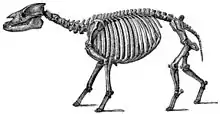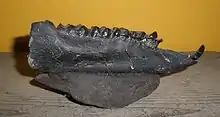Palaeotheriidae
Palaeotheriidae is an extinct family of herbivorous perissodactyl mammals that inhabited Europe, with less abundant remains also known from Asia,[3] from the mid-Eocene to the early Oligocene. They are classified in Equoidea, along with the living family Equidae (which includes zebras, horses and asses).[4]
| Palaeotheriidae | |
|---|---|
 | |
| Palaeotherium magnum skeleton | |
| Scientific classification | |
| Domain: | Eukaryota |
| Kingdom: | Animalia |
| Phylum: | Chordata |
| Class: | Mammalia |
| Order: | Perissodactyla |
| Suborder: | Hippomorpha |
| Family: | †Palaeotheriidae Bonaparte, 1850 |
| Genera | |
| |
| Synonyms | |
|
Pachynolophidae Pavlow, 1888 | |
Morphology


Palaeothere sizes ranged from 20 to 75 cm (8 to 30 in) at the shoulder, and weighed an estimated 10–30 kg (20–70 lb).[5] Their teeth are brachydont (low crowned).[6]
Ecology
Early members of the family are suggested to have been frugivores, with later, larger members suggested to be browsers.[6]
Extinction
Evidence suggests that palaeotheriids went extinct in Eurasia during the Early Oligocene, approximately 33 Ma, as part of a faunal turnover event known as the Grande Coupure. The Eocene-Oligocene transition marked a significant global cooling event caused by the onset of Antarctic glaciation. This resulted in drier and more open habitats dominating the early Oligocene, and the loss of the dense forests that characterised the Eocene epoch. This environmental change, coupled with the arrival of new and better-adapted mammalian groups from Asia, triggered a decline in endemic European mammal groups such as Palaeotheriidae and Anoplotheriidae. In the Hampshire Basin of southern England the last record of Paleotheriidae is from the Lower Hamstead Mbr. of the Bouldnor Formation, dating to approximately 33.6 Ma.
Fossil distribution
- Creechbarrow Hill Site, Dorset, England
- Geiseltal, Mittelkohle, Zone III, Saxony-Anhalt, Germany
- Egerkingen, Alpha & Beta fissures, Baselland, Switzerland
- La Debruge, Provence-Alpes-Côte d'Azur Region, France
- The Caucasus Mountains in Georgia
See also
References
- Perales-Gogenola, L.; Badiola, A.; Gómez-Olivencia, A.; Pereda-Suberbiola, X. (2023). "A remarkable new paleotheriid (Mammalia) in the endemic Iberian Eocene perissodactyl fauna". Journal of Vertebrate Paleontology. 42 (4): e2189447. doi:10.1080/02724634.2023.2189447. S2CID 258663753.
- Remy, Jean A.; Krasovec, Gabriel; Marandat, Bernard (2016). "A new species of Propalaeotherium (Palaeotheriidae, Perissodactyla, Mammalia) from the Middle Eocene locality of Aumelas (Hérault, France)". Palaeovertebrata. 40 (2): e1. doi:10.18563/pv.40.2.e1.
- Bai, Bin (November 2017). Hautier, Lionel (ed.). "Eocene Pachynolophinae (Perissodactyla, Palaeotheriidae) from China, and their palaeobiogeographical implications". Palaeontology. 60 (6): 837–852. doi:10.1111/pala.12319. ISSN 0031-0239.
- Perales-Gogenola, Leire; Badiola, Ainara; Gómez-Olivencia, Asier; Pereda-Suberbiola, Xabier (2021-01-02). "New Leptolophus (Palaeotheriidae) species from the Iberian Peninsula and early evidence of hypsodonty in an Eocene perissodactyl". Journal of Vertebrate Paleontology. 41 (1). doi:10.1080/02724634.2021.1912061. ISSN 0272-4634.
- S. Legendre. 1988. Les communautes de mammiferes du Paleogene (Eocene superieur et Oligocene) d'Europe occidentale: structure, milieux et evolution. Ph.D. thesis, Universite des Sciences et Techniques du Languedoc, Montpellier, France. 2 volumes. 1-265
- Engels, Sandra; Schultz, Julia A. (June 2019). "Evolution of the power stroke in early Equoidea (Perissodactyla, Mammalia)". Palaeobiodiversity and Palaeoenvironments. 99 (2): 271–291. doi:10.1007/s12549-018-0341-4. ISSN 1867-1594.